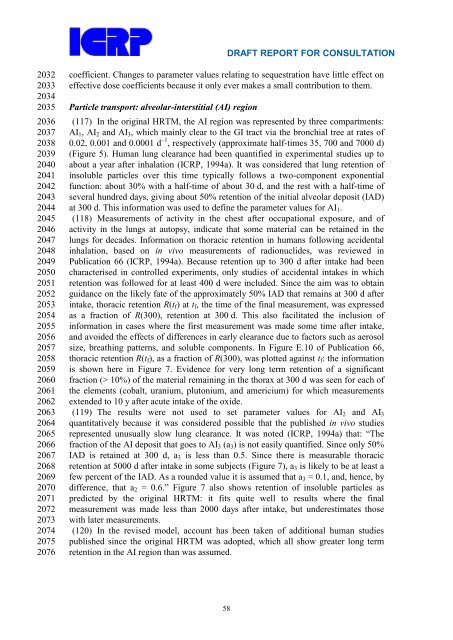Occupational Intakes of Radionuclides Part 1 - ICRP
Occupational Intakes of Radionuclides Part 1 - ICRP
Occupational Intakes of Radionuclides Part 1 - ICRP
You also want an ePaper? Increase the reach of your titles
YUMPU automatically turns print PDFs into web optimized ePapers that Google loves.
2032<br />
2033<br />
2034<br />
2035<br />
2036<br />
2037<br />
2038<br />
2039<br />
2040<br />
2041<br />
2042<br />
2043<br />
2044<br />
2045<br />
2046<br />
2047<br />
2048<br />
2049<br />
2050<br />
2051<br />
2052<br />
2053<br />
2054<br />
2055<br />
2056<br />
2057<br />
2058<br />
2059<br />
2060<br />
2061<br />
2062<br />
2063<br />
2064<br />
2065<br />
2066<br />
2067<br />
2068<br />
2069<br />
2070<br />
2071<br />
2072<br />
2073<br />
2074<br />
2075<br />
2076<br />
DRAFT REPORT FOR CONSULTATION<br />
coefficient. Changes to parameter values relating to sequestration have little effect on<br />
effective dose coefficients because it only ever makes a small contribution to them.<br />
<strong>Part</strong>icle transport: alveolar-interstitial (AI) region<br />
(117) In the original HRTM, the AI region was represented by three compartments:<br />
AI1, AI2 and AI3, which mainly clear to the GI tract via the bronchial tree at rates <strong>of</strong><br />
0.02, 0.001 and 0.0001 d –1 , respectively (approximate half-times 35, 700 and 7000 d)<br />
(Figure 5). Human lung clearance had been quantified in experimental studies up to<br />
about a year after inhalation (<strong>ICRP</strong>, 1994a). It was considered that lung retention <strong>of</strong><br />
insoluble particles over this time typically follows a two-component exponential<br />
function: about 30% with a half-time <strong>of</strong> about 30 d, and the rest with a half-time <strong>of</strong><br />
several hundred days, giving about 50% retention <strong>of</strong> the initial alveolar deposit (IAD)<br />
at 300 d. This information was used to define the parameter values for AI1.<br />
(118) Measurements <strong>of</strong> activity in the chest after occupational exposure, and <strong>of</strong><br />
activity in the lungs at autopsy, indicate that some material can be retained in the<br />
lungs for decades. Information on thoracic retention in humans following accidental<br />
inhalation, based on in vivo measurements <strong>of</strong> radionuclides, was reviewed in<br />
Publication 66 (<strong>ICRP</strong>, 1994a). Because retention up to 300 d after intake had been<br />
characterised in controlled experiments, only studies <strong>of</strong> accidental intakes in which<br />
retention was followed for at least 400 d were included. Since the aim was to obtain<br />
guidance on the likely fate <strong>of</strong> the approximately 50% IAD that remains at 300 d after<br />
intake, thoracic retention R(tf) at tf, the time <strong>of</strong> the final measurement, was expressed<br />
as a fraction <strong>of</strong> R(300), retention at 300 d. This also facilitated the inclusion <strong>of</strong><br />
information in cases where the first measurement was made some time after intake,<br />
and avoided the effects <strong>of</strong> differences in early clearance due to factors such as aerosol<br />
size, breathing patterns, and soluble components. In Figure E.10 <strong>of</strong> Publication 66,<br />
thoracic retention R(tf), as a fraction <strong>of</strong> R(300), was plotted against tf: the information<br />
is shown here in Figure 7. Evidence for very long term retention <strong>of</strong> a significant<br />
fraction (> 10%) <strong>of</strong> the material remaining in the thorax at 300 d was seen for each <strong>of</strong><br />
the elements (cobalt, uranium, plutonium, and americium) for which measurements<br />
extended to 10 y after acute intake <strong>of</strong> the oxide.<br />
(119) The results were not used to set parameter values for AI2 and AI3<br />
quantitatively because it was considered possible that the published in vivo studies<br />
represented unusually slow lung clearance. It was noted (<strong>ICRP</strong>, 1994a) that: “The<br />
fraction <strong>of</strong> the AI deposit that goes to AI3 (a3) is not easily quantified. Since only 50%<br />
IAD is retained at 300 d, a3 is less than 0.5. Since there is measurable thoracic<br />
retention at 5000 d after intake in some subjects (Figure 7), a3 is likely to be at least a<br />
few percent <strong>of</strong> the IAD. As a rounded value it is assumed that a3 = 0.1, and, hence, by<br />
difference, that a2 = 0.6.” Figure 7 also shows retention <strong>of</strong> insoluble particles as<br />
predicted by the original HRTM: it fits quite well to results where the final<br />
measurement was made less than 2000 days after intake, but underestimates those<br />
with later measurements.<br />
(120) In the revised model, account has been taken <strong>of</strong> additional human studies<br />
published since the original HRTM was adopted, which all show greater long term<br />
retention in the AI region than was assumed.<br />
58

















